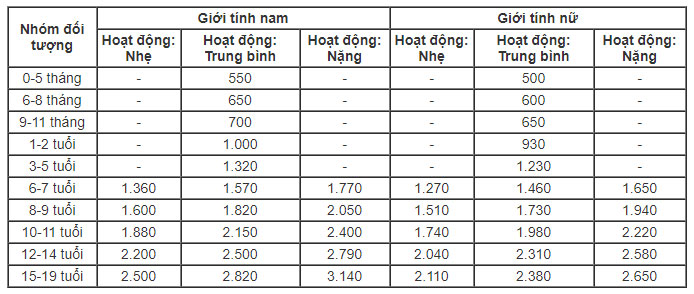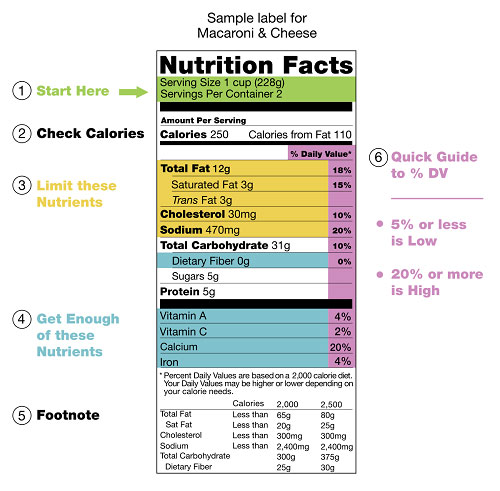Eating science based on recommended nutritional needs
Recommendations on nutritional needs to help select energy supply foods; Suitable protein, carbohydrates, fats, vitamins, minerals for children.
Recommended dietary intake (RDA) is the nutrient level that each person should consume for energy, basic nutritional ingredients that are considered adequate to maintain the body's health.
Nutritional needs recommend different RDA depending on gender, age, level of physical activity, physiological status. According to the specialist 2 Do Thi Ngoc Diep, Vice Chairman of Vietnam Nutrition Association, when building the recommended nutritional needs, countries must also rely on the ability to provide food, eating habits and love. Nutrition and health status of the community to ensure scientific and appropriate nutrition recommendations.
According to the nutritional needs recommended by the Nutrition Institute, the energy requirement for children 0-5 months is 550kcal a day; boys 6-8 months is 650kcal, girls 600kcal . From 6-7 years old, depending on the activity is light, medium, heavy, the demand will be different. RDAs in countries often have energy, nutrient and energy recommendations that include protein; sugar; fat; vitamins, minerals, fiber.
Table of energy needs for each age, calculation unit: kcal

According to the World Health Organization (WHO) and the United Nations Food and Agriculture Organization (FAO), many countries have made recommendations on nutritional needs to help people choose appropriate food.
Doctor Ngoc Diep said, RDA also plays a role in building appropriate diet, limiting nutritional deficiencies leading to malnutrition, stunting or overweight, obesity. For example, to prevent protein deficiency, boys 6-7 years of age need to provide 33g per day, 8-9 years old is 40g, 50g for children 10-11 years old; sugar powder in turn is 210-230g, 250-270g, 290-320g .
Parents can refer to RDA to provide natural food (vegetables, tubers, fruits, meat, fish, eggs .) with essential substance groups, daily energy for the body. With pre-processed foods, from RDA, nutrition experts provide practical guidance; manufacturers provide nutritional information on food packaging labels (Nutrition information or Nutrion facts).
Dr. Ngoc Diep added that there are now many countries that have regulations on industrial processed food products to disclose nutrition information with basic contents such as energy, protein ingredients and substances. fat, sugar, salt, sugar, saturated fat, trans fat, some vitamins, some minerals as well as the rate that meets nutritional recommendations (Percent of daily value -% DV) .
This regulation is not only to support consumers with information to build a reasonable diet, encourage producers to offer balanced nutrition products, help agencies manage more easily but also improve their health. healthy, prevention of non-communicable diseases is increasing rapidly. In the process of international integration, Vietnam is also encouraging food producers to comply with the above international practice.
Instructions for reference nutrition labels on packaging
Nutritional information on products is also called nutritional labels that directly affect consumers. Here are some guidelines for parents to refer to the information on the nutrition label.

Product packaging labels give parents more nutritional information to choose ready-to-eat foods that match their needs.
- Serving size: parents see the serving at the top of the food nutrition label. The unit of the serving is standardized on the label like grams or a cup, a pack, a serving . For example, the serving size on this product is a cup (weight 228g).
- Total calories and fat (fat and calories from fat): in each serving, the calories that a serving provides and the calories supplied from the fat in the product. For example, each serving provides 250 calories, including 110 calories from fat.
- Total fat: The fat of the product is divided into total fat, trans fat and saturated fat.
- Cholesterol and sodium (cholesterol and sodium) are substances that need to be absorbed, usually in yellow color, and a green color stimulant. If you absorb a lot of cholesterol and salt can increase the risk of diseases such as cardiovascular disease, hypertension, cancer . For example, this product has cholesterol of 30mg, 470mg sodium.
- Sugar powder (carbohydrate) and protein (protein): carbohydrates and protein are important groups of everyday substances. The total amount of carbohydrate (total carbohydrate) in the above product also includes 5g sugar (sugar) but no dietary fiber. Some countries are required to publish cholestorol, salt, trans fat, sugar because salt contains a lot of sodium, causing high blood pressure and sugar, which increases the risk of obesity, trans fat, and easily lead to cardiovascular disease .
- Vitamins and minerals: blue groups of substances are encouraged to absorb such as vitamin A, vitamin C, calcium (calcium), iron (iron).
- Daily nutritional value (Percent of daily value, referred to as% DV): indicates how much the product provides for the recommended RDA for the body for a person in a day.
- How to read nutrition labels on packaging: Dr. Ngoc Diep shared, if you want to read the nutrition labels of processed products to see how much you meet the recommended nutritional needs (RDA), steps parents must first know how much energy is required by their child's recommended needs, see the packaging that lists the nutritional ingredients in the food; ingredients like protein, sugar, fat .; weight in ingredients (may be expressed in g, mg .); Daily nutritional value (% DV) indicates how much the product provides for the body's recommended nutritional needs.
For example, the composition of total fat products, total weight of 12g, total fat content compared to the recommended demand, is 18%. The product contains carbohydrates, weight of 31g, total carbohydrate compared to the recommended demand of 10%. Fiber is not included in the product (dietary fiber 0%) . Note, note the note to determine what percentage (%) of the recommended nutrient requirement is calculated on the energy demand level to avoid inconsistency. my child. The example in the above product is compared to the daily energy of 2,000kcal.
When using pre-processed foods, parents often do not have the habit of reading nutrition information on products but decide based on their own interests or children's interests, product forms, advertising, promotions. , brand . so it may not be possible to choose scientific food to solve nutritional problems for children. Parents should consult the recommended nutritional needs, nutrition towers, official sources of information, and choices based on their health situation.
- 5 Abstain taboo of people with cancer
- Eating and drinking habits are right and wrong
- Should choose milk according to nutritional needs
- Great nutritional value in small okra fruits
- Note when eating snails to avoid processions into the body
- Why do people crave 'eating bad'?
- It is recommended to dry mushrooms in the sun before eating
- Threat from 'nutritional deviance'
- Eating light will help reduce premature birth rates
- Prehistoric people eating each other
- 7 extremely harmful eating habits
- Eating salt kills 1.6 million people every year
 Green tea cleans teeth better than mouthwash?
Green tea cleans teeth better than mouthwash? Death kiss: This is why you should not let anyone kiss your baby's lips
Death kiss: This is why you should not let anyone kiss your baby's lips What is salmonellosis?
What is salmonellosis? Caution should be exercised when using aloe vera through eating and drinking
Caution should be exercised when using aloe vera through eating and drinking How can using cooking oil incorrectly cause increased blood fat?
How can using cooking oil incorrectly cause increased blood fat?  Why are Japanese Sumo Wrestlers Called 'Healthy Obese'? - The Surprising Answer!
Why are Japanese Sumo Wrestlers Called 'Healthy Obese'? - The Surprising Answer!  Interesting dishes from Asia are a 'miracle drug' to reduce excess fat and blood fat
Interesting dishes from Asia are a 'miracle drug' to reduce excess fat and blood fat  Top 5 foods high in bad fats
Top 5 foods high in bad fats  Despite being called a 'shark', this species has the best body in the world, not a single individual is overweight.
Despite being called a 'shark', this species has the best body in the world, not a single individual is overweight.  The unexpected reason why skinny people still have fatty liver
The unexpected reason why skinny people still have fatty liver 